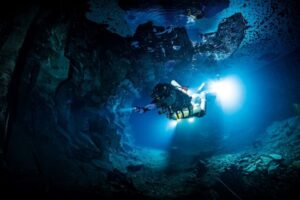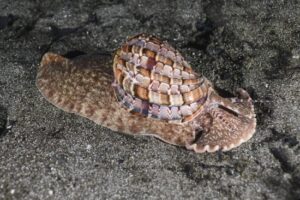I have been living in Iceland for the past 7 years working in the dive industry. When everyone thinks of diving in Iceland they always bring to mind the world famous Silfra fissure. Silfra is an underwater visibility wonderland and famous for good reason. But, when it becomes your office and your local dive site, your mind starts to wander to the other types of diving that can be done in Iceland. The local dive community is quite small and weather conditions are difficult. So, finding new places to dive can be a little tricky.
But, after a few years in Iceland, I had dived all of the known sites including the wrecks in the Easy Geothermal lakes close to Reykjavik, Hydrothermal cones in the North, and ice diving in the lakes in the summer.
I had been going on a few glacier hikes, and the idea came to me of diving inside a Glacier. I began to research it and talk to local glacier experts about the idea of diving in a Moulin, but nothing had come to fruition.
Iceland had been seeing an increase in people going to naturally formed ice caves in the winter. These caves are formed in the summer months. As temperatures rise and the glaciers begin to melt, the water has to find its natural path down through the glacier and out to the lower ground and lagoons. As Autumn approaches and the temperatures being too plummet at night again, the glaciers stop melting and the water flow that forms these caves begins to drop down until ultimately it leaves behind an ice cave. They can come in all forms and sizes, and the ice can be of different colours from grey to black. The most impressive ice caves have blue walls.
In the winter season, we became aware of an ice cave on Langjökull glacier in South West Iceland. The glacier is 50km long and has a maximum elevation of 1450m. The cave was difficult to reach though, at a height of 850m.
Our team first visited this ice cave at the peak of the winter while the cave was still completely air filled, which enabled us to explore and navigate the cave by foot. It was a great way to familiarise ourselves with this cave and the environment for what we were hoping to do later on. At this moment, we were not yet sure what would happen with the cave at the end of the winter. It could either melt and collapse under the snow pressure, or the structure of the cave could stay intact by the air replaced by meltwater from the glacier itself. We were of course hoping for the latter.
A few months later, just as winter was about to turn to spring, our team had heard that the cave had begun to flood and the water level was rising. The cave was no longer accessible by foot. We knew that time was of the essence and there would be a short window where the cave was still strong enough and stable enough to dive before the temperature and meltwater made it collapse or the water flow became too strong.
We immediately sent a date for the upcoming weekend to try and dive the cave. The remote location of the cave requires some planning in terms of gear and logistics. The only way to get to the glacier from our base in Reykjavik is by super jeep. A Super Jeep is a modified 4 by 4 vehicle that has 46 inch tyres with inflation systems to allow it to travel in deep snow conditions. We started in the morning by loading twinsets, drysuits, lights, ropes, oxygen, and camera gear into a modified Mercedes Jeep, and then set off towards Langjökull.
A few hours later, we arrived at the base of the glacier where it was time for the next leg of our journey – snowmobiling over the ice cap in order to get to the remote ice cave 850 m above sea level. Due to the unpredictable Icelandic weather, we decided to jump in our drysuits before getting on the snowmobiles. The rest of the gear was loaded onto snow sledges that we would tow behind the snowmobiles.
Just short of an hour later, we arrived at the cave location and were now facing the moment of truth; would the cave still be there, and if so, would the conditions allow us to dive it? Lots of snow was covering the opening to the cave. Before we could find out what it looked like, we had to dig our way to the entrance. A few moments later, we were about to find out if our efforts would have been all for nothing. We poked our heads into the entrance and witnessed crystal clear meltwater from the glacier filling up the cave. The structure was still intact with the roof and walls looking stable. We looked at each other with excitement and joy; this was exactly what we were hoping for.
Our Magmadive team for the day consisted of five people, all professional cold water divers and with Ice Diving Instructor and Altitude Diving Instructors within the team. Four of the team would dive, two at a time, and one would act as line tender and surface support. Our lead diver was Kuba, an incredibly experienced cold water diver and Ice Diving Instructor. He has been guiding ice divers in Iceland for many years, and was always as cool as ice himself. The perfect person you would want as a lead diver on such an exploration trip.
We had been towing the equipment on sledges. All of the regulators and twinsets had already accumulated a lot of snow and ice around the valves, making things quite difficult. Everyone would be diving on twinsets though for redundancy reasons. We removed all of the snow from the equipment while air temperatures were pretty favourable, hovering around 0 degrees Celsius. There was no quick freezing of equipment. We were all used to diving in air temperatures as low as -20 degrees Celsius, so we were grateful for the benign conditions.
As the first, two divers were getting ready and I took a moment to soak in the fact that I am standing in the middle of one of Europe’s largest glaciers, preparing for a dive that no one have ever attempted before. The word “exploration” is a word I think is used way too often. Everyone descries themselves as an explorer even when they are following in the footsteps of others. I have been on many dive expeditions around the world, but they are just that, expeditions. This is the closest I have come to the feeling of exploration. We genuinely did not know how the conditions would be inside the cave or what we could expect.
We had chosen to use Ice Diving procedures for this dive rather than cave diving procedures. Ice diving procedures involve having a permanent line connected to the primary lead diver, then looped through the harness of the second diver with the other end going directly to a surface support. We did not know how the conditions would be underwater. By using this method, we could have a rudimentary communication system between the surface and dive team. Because of the dangerous nature of the dive, and the likelihood of changing conditions both topside or underwater, it was much better to have the permanent connection.
Land conditions could have changed at any time. The entrance to the cave could collapse as we did not know how stable it was, especially as we had removed all of the supporting snow that was blocking the entrance.
Kuba and I were the first in the team to dive with Kuba leading the way through the cave keeping the communications with Maria, our surface support. I was the photographer for the trip, and having the permanent line made it nice and easy for me to move around and not have to worry about moving away from the main line.
Kuba headed in first, with me very close behind. The cave was of course completely dark, pitch black. As I went down the entrance I couldn’t see much other that the back of Kuba’s fins. The entrance was tight and restricting. As we got to a depth of around 5m, we arrived at the first chamber and Kuba and I could get a little space and flash out lights around the cave for the first time.
We had hit the jackpot, the cave had become completely flooded with crystal clear water. This was just melt water and the real flow through the glacier had not yet begun. Once the water starts flowing in the peak of the summer, it will be dirty and brown as it brings the glacier sediment along with it. But, conditions for us were perfect. The water was as clear as air. It was surface melt that had been filtered by the remaining snow.
The cave had two chambers. When we had visited in the winter, one of the best features was a frozen pillar inside the cave. This was actually a waterfall that had been flowing through the middle of the cave. When the lower winter temperatures and come in, it had literally frozen the waterfall in place. As we made our way to the second chamber, Kuba turned to me and gave me an ok signal and pointed in the direction of the frozen waterfall. I shone my torch forward and there she was. Still standing proud in the middle of the chamber.
Now came the real task at hand. To document what we experienced and what we had seen. The cave was completely dark with no ambient lighting at all. I had bought with me two Keldan 12,000 lumen video lights, and two on-camera strobes to try to light the cave.
Kuba and I positioned the video lights at either end of the cave, and once both were in position, we could see the beauty of the cave in full. The water was so clear that the light penetrated across the entire area. The walls were made of an incredible blue ice that you could only see when the light punched through it.
Kuba positioned himself in the middle of the cave, and gave me a little slack on the line so I could get some space to start the photos. It took me a while to set the camera up to balance the light sources from the video lights, Kuba’s primary light, and the strobes.
As we started photographing, I was amazed at the colours of the ice on the back of the LCD screen on the camera; the blue was out of this world. After the photoshoot, we took a minute to just enjoy the moment before turning back to the entrance and ascending from this magical dive.
When we returned to the surface, we could see the anticipation on the other divers’ faces. They were keen to know how it was and if all the effort was worth it. Kuba and I gave them a little grin and they knew that they were in for one of the most amazing dives of their lives.
The next pair went for a dive, and then I completed one more dive with a different model just to get some additional photos.
After the dives were complete, we all joined on the surface and reflected on what we had seen. We were the first people to run a dive expedition into an ice cave in Iceland. To literally dive a flooded chamber inside a glacier was an incredible feeling. After many thousands of dives all over the world in different situations, this was the closest I had come to the feeling of exploration.
Read MoreMonthly Blog Posts, diving, photography, scuba, scuba diving, tec dive, technical divingShearwater Research



